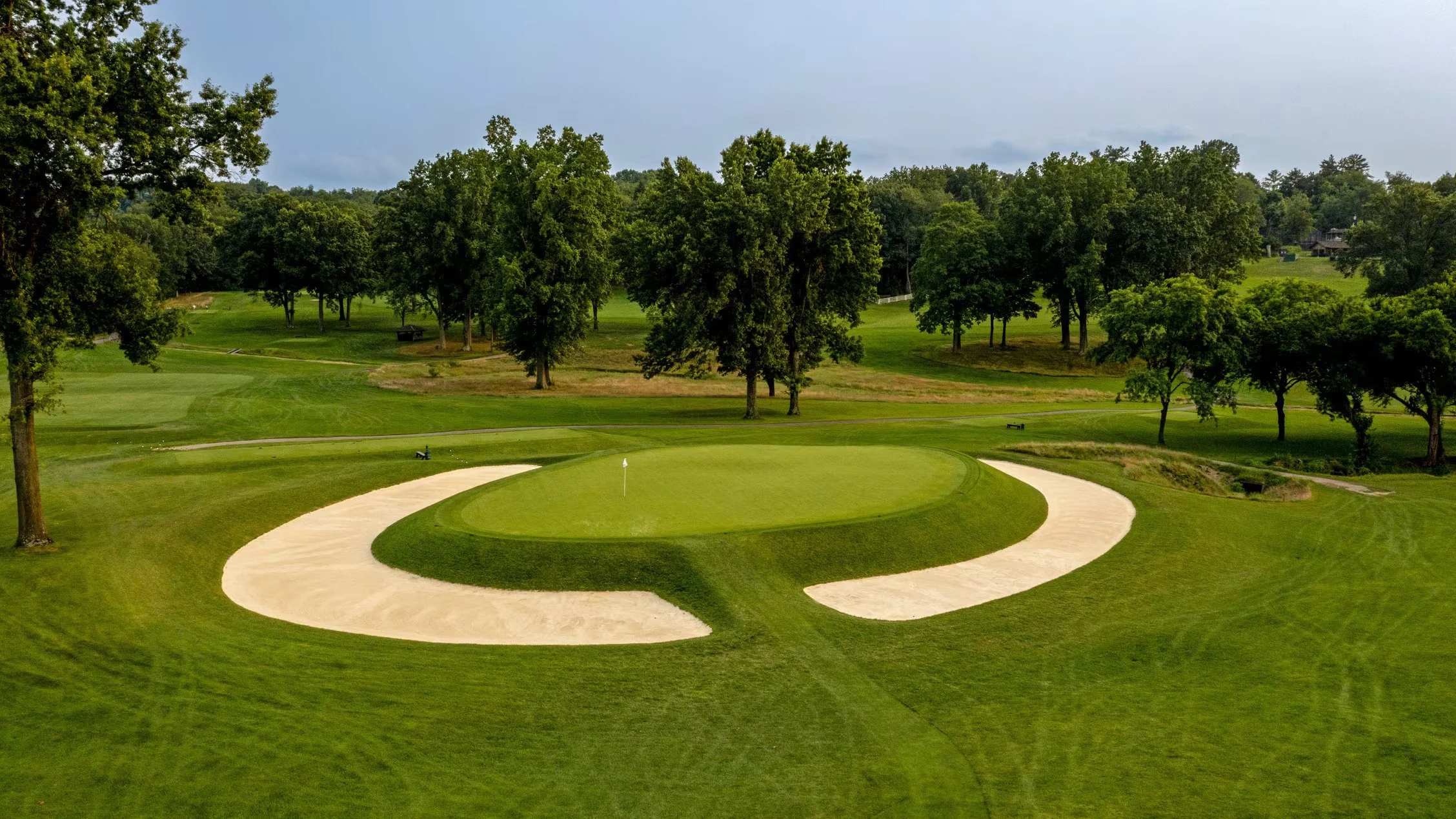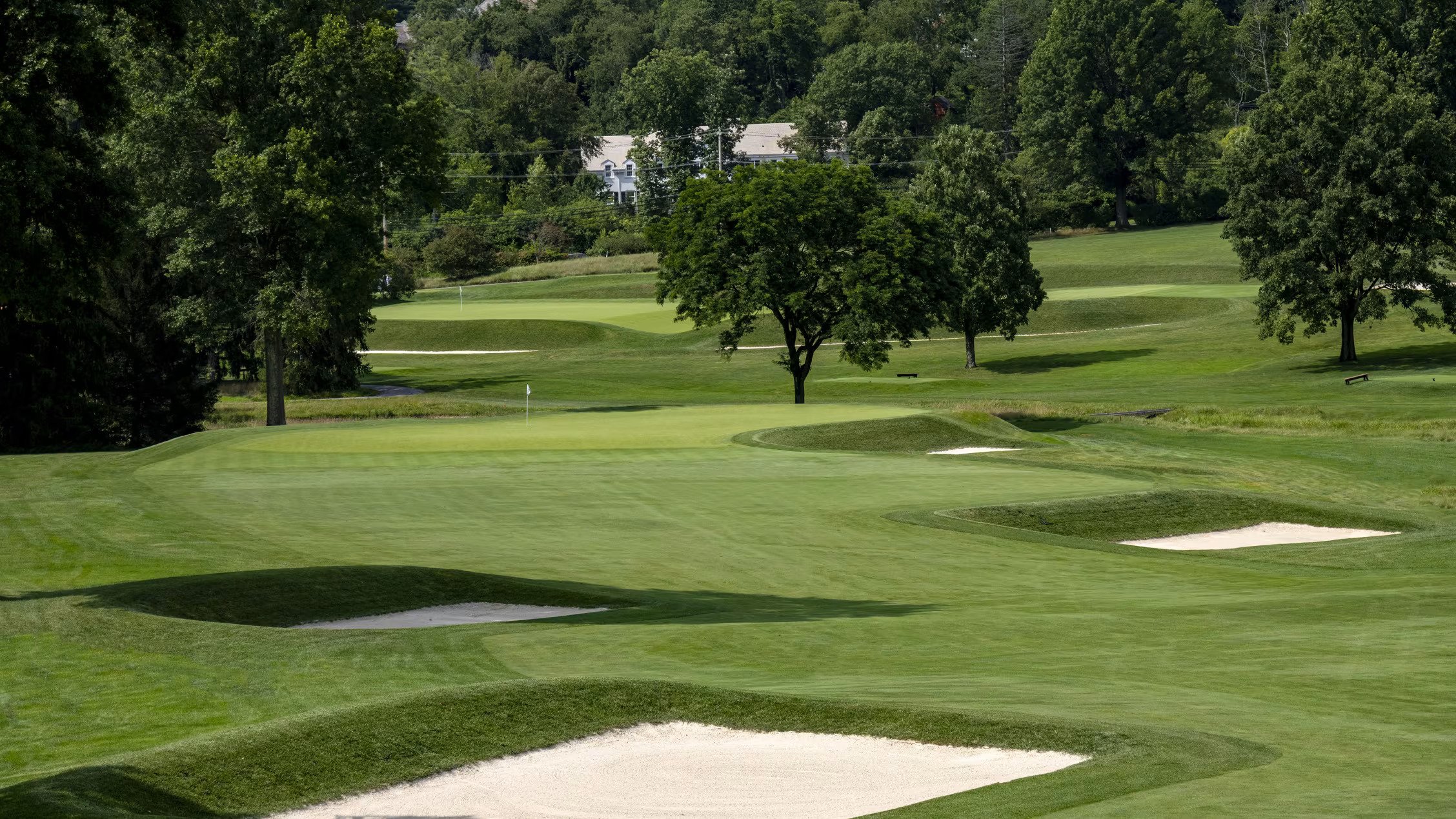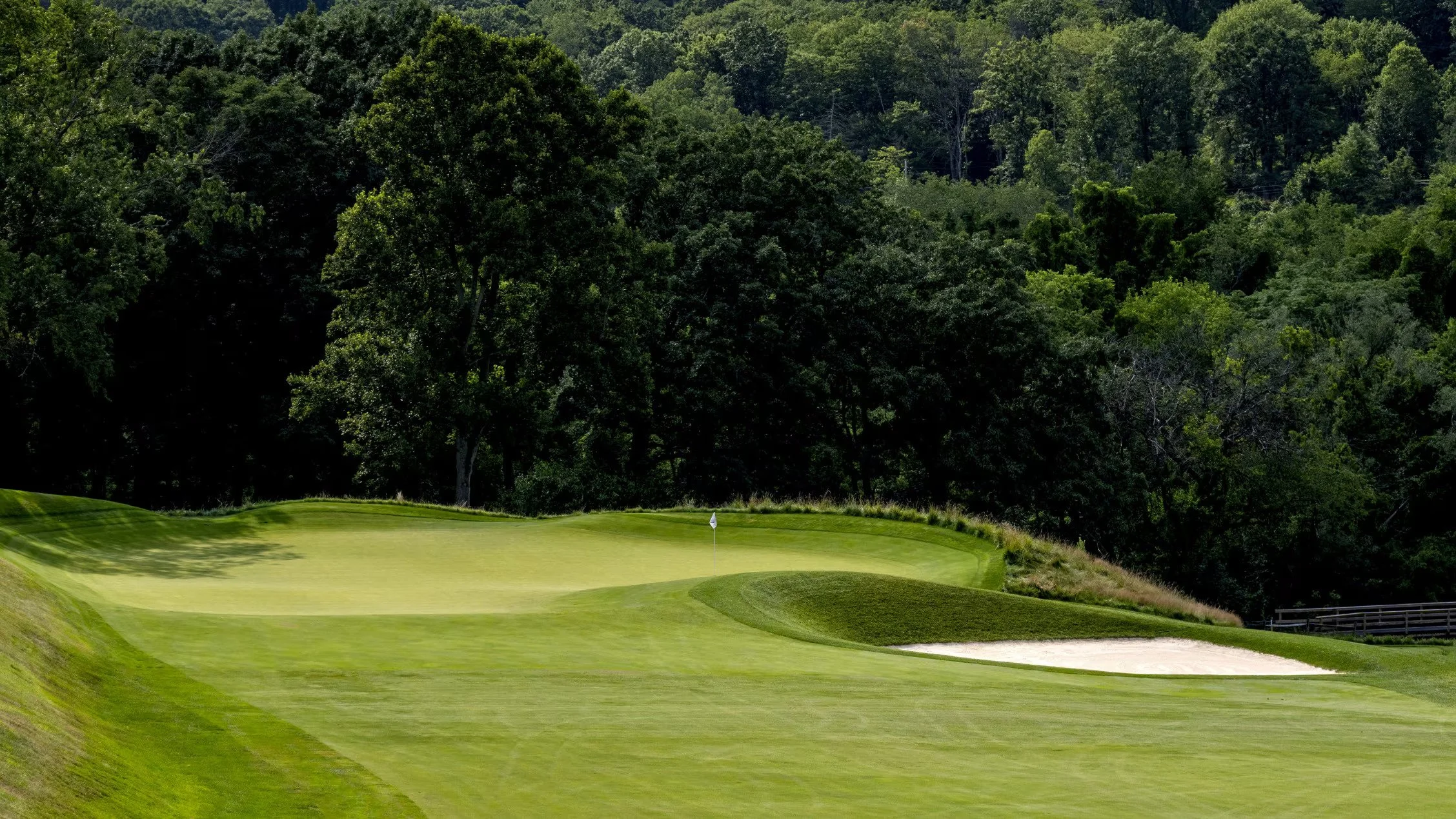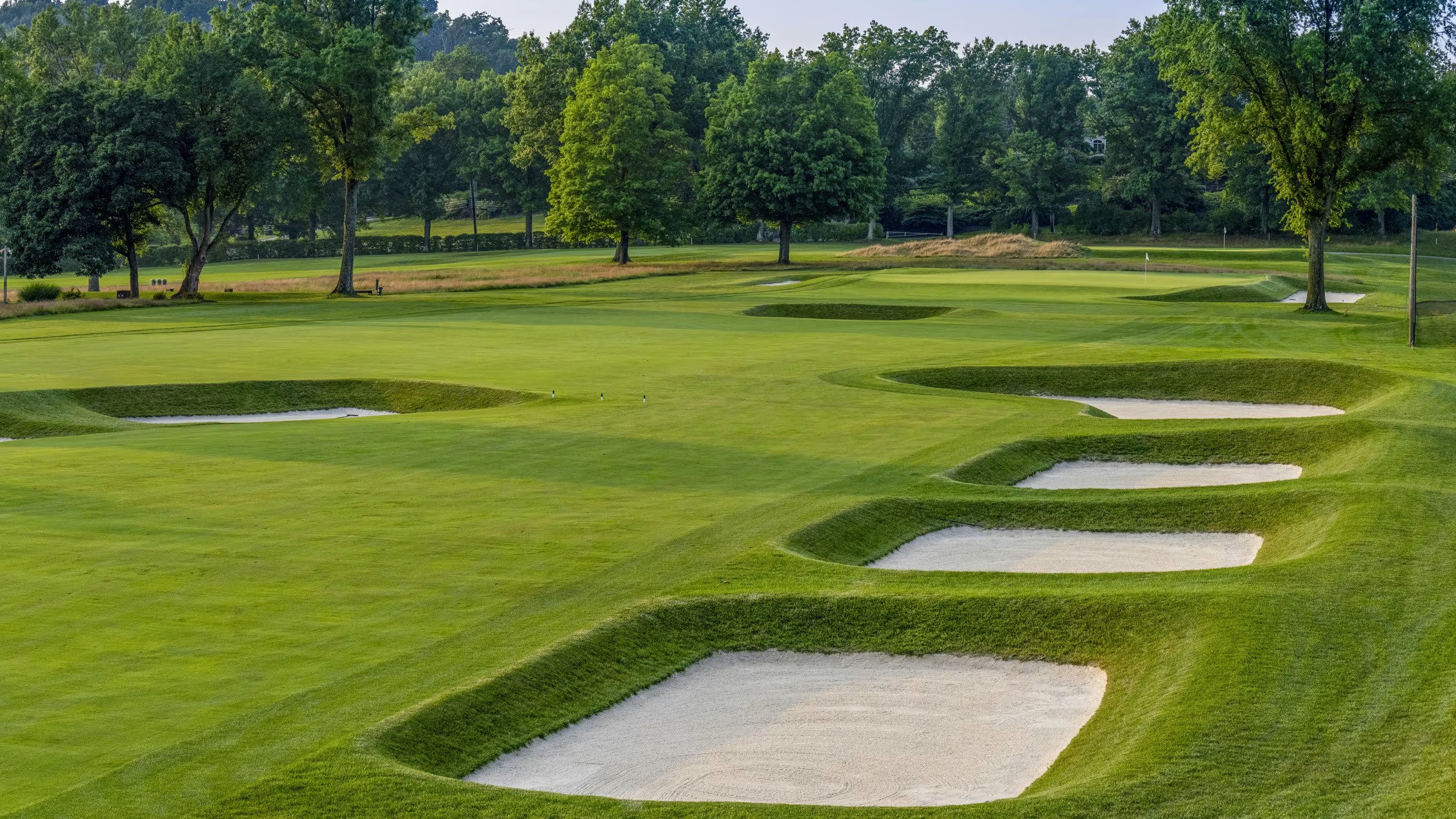FOX CHAPEL GOLF CLUB
Course Architect(s): Seth Raynor (1925); Brian Silva (1990s, 2001), Tom Marzolf (2020)
Year Opened: 1925
Location: Pittsburgh, Pennsylvania
Slope: 137. Rating: 73.3
Par: 70
Yardage: 6,705
Hole-by-Hole: 1 - Par 4 411 Yds 10 - Par 4 402 Yds
2 - Par 5 472 Yds 11 - Par 3 181 Yds
3 - Par 3 195 Yds 12 - Par 4 344 Yds
4 - Par 4 480 Yds 13 - Par 4 422 Yds
5 - Par 4 335 Yds 14 - Par 4 453 Yds
6 - Par 3 190 Yds 15 - Par 4 400 Yds
7 - Par 4 283 Yds 16 - Par 4 421 Yds
8 - Par 5 474 Yds 17 - Par 3 229 Yds
9 - Par 4 443 Yds 18 - Par 5 570 Yds
Par 36 3,283 Yds Par 35 3,422 Yds
Key Events Held: U.S. Senior Amateur (1965),
U.S. Women's Amateur (1985),
Curtis Cup (2002), Lesley Cup (1997, 2011),
Senior Players Championship (2012-14).
Awards Won: Top 100 Best Classic Courses by Golfweek Magazine (2014-15),
The 100 Most Prestigious Golf Clubs by Links Magazine.
Website: foxchapelgolfclub.org
HISTORY: The course came into existence due to the diligence of several men, including William L. Mellon and George M. Laughlin, Jr., who gave a dinner at Pittsburgh Golf Club to 50 gentlemen. The exuberance for the idea of a new golf club was so intense that $152,000 was raised by those in attendance.
Work began almost immediately on the course and clubhouse. Alden & Harlow designed the original clubhouse while Seth Raynor was chosen for course design. Raynor, who worked closely with C.B. McDonald, the designer of the National Golf Links on Long Island, crafted many holes that bear an uncanny resemblance to those of the National.
Although work began on the course in 1923, it took more that two years to get the venue in shape prior to opening. Estimates to build Fox Chapel began at $75,000, but finally finished at $220,000. In just a short period of time, the membership grew and a special meeting was held to decide to expand and redesign the clubhouse. Architect Brandon Smith was hired to demolish the original building with the exception of a portion of the men's locker room. The new building opened on Memorial Day in 1931.
Although there have been additions to the clubhouse (grill room, pro shop, etc.), it is basically much the same as when erected. The golf course still retains the essence of Raynor's design, although fairway contours, tee boxes and putting surfaces have been altered over the years. Over the past few seasons, all of the bunkers have been reworked and redesigned and are now up to Fox Chapel standards.
This outstanding facility has hosted two outstanding events, the U.S. Senior Amateur in 1965 captured by Robert Kiersky and the 1985 Women's Amateur captured by Michiko Hattori. The next major event for Fox Chapel was the 2002 Curtis Cup, where the United States women amateurs defeated players from Great Britain and Ireland, 11-7.
Six-time U.S. national champion Carol Semple Thompson and Women's Amateur champion Meredith Duncan led the squad for the U.S. while two-time Curtis Cupper Rebecca Hudson led GB&I.
The United States led 3-0 after the morning foursomes and never looked back, taking a 7-2 advantage after day one. GB&I took five of the last nine points, but it was not enough as the U.S. improved to 23-6-3 in Curtis Cup play.
The Senior Players Championship moved to Fox Chapel in 2012 for three consecutive events. Joe Daley posted a two-stroke win over Tom Lehman the first year. Kenny Perry shot an event record of 261 the following year to defeat Fred Funk by five shots and Bernhard Langer completed the three-year stint at Fox Chapel with a playoff victory over Jeff Sluman.
REVIEW: The course starts out with a beautiful par-four that bends from left to right with a rolling fairway, one of the signature parts of the course, with bunkers left and right. The green slopes from left to right and is flanked by high-faced bunkers.
Hole number two is a short, but demanding par-five. At just 472 yards, many would think that birdie would be easy, however, a misplaced tee shot to an uphill fairway will cause many problems. Out of bounds looms left along with bunkers and tall trees, while the fairway slopes severely from left to right. The approach shot to the green is downhill to a putting surface that is guarded by sand and is situated in between mounding. Miss the green left and say goodbye, miss right and double-bogey is a distinct possibility.
A beautiful par-three awaits the players on number three. At 195 yards, this one-shotter must carry over Glade Lake to a sloping green from left to right and back to front. The false front and the several bunkers that guard the putting surface, make par a good score.
The par-four, fourth hole is the most difficult on the course at 480 yards from tips. The uphill tee shot needs to swing from right to left and avoid the bunkers. After a successful tee ball, the player is left with a long iron or fairway metal to a large green, well guarded by bunkers. The green slopes from back and left to front and right and is extremely quick.
A reprieve of sorts at number five. Just 335 yards, the fifth is one of those holes that requires correct club selection off the tee to a fairway guarded on the right side by bunkers and on the left by a stream to a sloping right to left fairway. The second shot carries over a creek to an uphill green that is fairly flat. After most likely dropping a shot on four, here's your chance to get it back.
The sixth is a majestic par-three guarded on both sides by massive bunkers with equally massive lips. A very long and narrow green features a slope from front to back. Getting up and down from the sand is next to impossible, especially on your first try. One final note, the spine in the middle section moves the ball from the right to the left.
The short seventh, just like the fifth requires proper club selection. At 283 yards, its the shortest par-four on the course with bunkers on the left side of the fairway and trees and mounding on the right. The green is treacherous with a huge fronting bunker to a slick undulating surface that slopes from left to right and back to front.
The shortest par-five on the course, the eighth is just 474 yards, but plays uphill to a small, shallow green. The fairway is guarded on the left by bunkers and on the right by a stream and
sand. With an accurate tee shot, players will have a definite birdie opportunity and a possible eagle attempt.
The final hole on the outward nine is a beauty at 443 yards, featuring a rolling fairway to a punchbowl type green. The putting surface is two-tiered and slopes from back to front and is
usually one of the quickest on the course.
Another two-tiered green is featured on the 10th, as players begin their march towards the clubhouse. After stopping for a drink at the halfway house, the tee shot on 10 must split the fairway, as thick rough awaits both left and right. The player is left with a medium to short iron to an undulating green that once again slopes to the front.
Although the shortest on the course, the 11th is one of the signature holes at Fox Chapel. Surrounded almost entirely by a sand moat, this devilish par-three at 156 yards requires pin-point accuracy to a green that is generally flat but putts uphill when the pin is in the back.
The par-four 12th doglegs right with large trees guarding the left side of the fairway. The green slopes from left to right and is guarded by a huge bunker. Although short at 344 yards, making par is OK as the quickness of the green dictates a three-putt. If you weren't challenged as of yet, the final six holes will test the best of players.
The 13th is a big dogleg right to a fairway that slopes left with large, tall trees and out of bounds guarding the entire right side of the hole. Even if you cut the corner, your tee shot will most likely roll into the rough, leaving a difficult mid iron approach. The good news...the putting surface is fairly flat, so getting up and down for par has good possibilities.
The 14th is a straightaway par-four with out of bounds on the right and trees left. The tee shot must carry on to the plateau leaving yourself with a mid to short iron approach to a small green, guarded left, right and back by bunkers. The hole is named Rodgers Field, as it was the first airport in Allegheny County, which was originally next to this hole.
The par-four 15th resembles the 12th in many ways. The tee shot requires proper club selection as to avoid bunkers and trees right to a relatively small fairway with a landing area that is fronted by a creek. The second shot with a wedge or nine-iron, must carry a huge gaping bunker fronting the green which slopes from back to front.
The 16th is probably the flattest hole on the course as it winds its way from left to right to a small green guarded on both sides by bunkers. The putting surface slopes from left to right and is
extremely fast. With 13 bunkers on this hole, you’ll be fortunate if you escape from the “Bottle.”
The par-three 17th is a humongous one-shotter at 231 yards from the back tees. The green is reminiscent of Yale Golf Course in Connecticut, featuring a huge swale in the front portion of the putting surface and a biarritz section in the center. A large moat style bunker guards the right side of the green while the left side falls off towards the 18th tee and more sand. In addition, one rectangular trap guards the entrance to the green. Parring 17 means you won the hole and have a good chance to win your match.
As you reach the final hole, you wish the round could go on and on. But, alas the 18th is truly a testing finisher at 574 yards. The hole bends from left to right with a creek that runs right and through the fairway, splitting the landing area. Large trees also guard the right side of the fairway, keeping the big hitters honest as they attempt to reach this monster in two. A successful lay up will leave an uphill wedge shot to a large green that slopes from right to left with the beautiful clubhouse in the background.
FINAL WORD: At just 6,705 yards from the back tees, one might think that Fox Chapel is a
push over, however don't be fooled. This Seth Raynor beauty has a wonderful Scottish feel that features amazing rolling fairways and deep, deep bunkers to greens that are very undulating and fast.
To say that this course is amazing is an understatement. The restoration work by Fazio Design’s Tom Marzolf brought Fox Chapel back to the 1923s original design by Seth Raynor.
New bunkers were added and reshaped, 97 in all. Everything that Raynor did back in the day was returned to its glory.
“In an era that rewards things new, this course will serve as the benchmark restoration on how to properly and historically preserve the game and recreate the flair of the 1920s golden era of golf course architecture,” said Marzolf. “The golf course looks like a genuine walk back in time to the 1920s!”
This is one of those courses that no one outside of Pittsburgh knows about, but should, as Fox Chapel has the ability to test the best of players.










